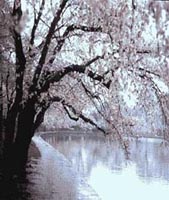Resource Library
Plant of the Week: Yoshino Cherry
The University of Arkansas System Division of Agriculture does not promote, support or recommend plants featured in "Plant of the Week." Please consult your local Extension office for plants suitable for your region.
Plant of the Week
Yoshino Cherry
Latin: Prunus x yedoensis

As we observe one of the rights of spring, filling out the uncomprehensible tax forms, it's understandable that the mind should wander towards Washington D.C. The naysayers have already said enough about government waste so instead lets focus on a positive aspect of our capitol city, the cherry blossoms. But Washington is a city whose lifeblood is politics so even these beautiful mementos of spring have a political aspect to their very existence.
The Yoshino cherries (Prunus x yedoensis) are small trees in the 25 to 30 foot range with their spread and height about equal. Like most cherries they are low branched. The trunks are marked with characteristic horizontal lines caused by a distortion of the bark due to the presence of lenticels, glands that provide air exchange for the trunk.
The five-petaled flowers of Yoshino cherries are mostly pale pink or white, depending on the variety. They are slightly fragrant and about the size of a quarter and borne in a cluster of four blooms on inch long peduncles. Blooms usually appear in early to mid April. The egg shaped fruit, if produced, is shining black and half inch long with a large pit. While the fruit are edible, Yoshino cherries are grown for their flowers.
This spring marks the one hundred year anniversary of the arrival of Yoshino flowering cherries in America. Their introduction was due to the efforts of David Fairchild, after whom Miami's Fairchild Tropical Garden is named. Fairchild (1869-1954) was the Federal government's first agricultural plant explorer who roamed the world between 1898 and 1902 looking for crops American farmers could grow.
He ran across the flowering cherries on a visit to Japan and fell in love with their grace and beauty. But working for the conservative U.S. Department of Agriculture, he couldn't expend government money on anything as frivolous as cherries grown for just their flowers. However, Fairchild had married well - the daughter of Alexander Graham Bell - so using his own resources he imported cherries for the home he and his wife were building in Chevy Chase, MD.
In 1908 he and Marian decided to take it upon themselves to beautify Washington DC, so they ordered flowering cherries for every school in the District and had an Arbor Day tree planting ceremony. This caught the attention of influential citizens and before long First Lady Taft was involved. With the weight of the First Lady behind the project a diplomatic arrangement was struck with the Mayor of Tokyo (the species epitaph "yedoensis" is from the old Japanese name for Tokyo, "Yeddo") and a shipment of large trees was sent.
The trees arrived in Seattle in January 1910 and fell under the watchful gaze of the Plant Quarantine section, another branch of the USDA. Much to the chagrin of all the politicos involved in the process, the inspectors didn't like what they saw so they piled the trees into a heap and burned the entire shipment. Fairchild shows a photo of the bonfire in his 1938 memoir, The World Was My Garden. The then newly formed Plant Quarantine section was formed in response to the chestnut blight, which was sweeping through the eastern states and they took their task very seriously, without regard to diplomatic niceties.
But the Mayor of Tokyo was not overly offended and two years later a shipment of Yoshino cherries arrived which made it through the quarantine process. By this time the Tidal Basin was nearing completion and the trees were used to grace the area.
Yoshino cherries are perhaps the best adapted of all flowering cherries to Arkansas conditions. In Fayetteville the flowering cherries surrounding the Square garden are seedlings of this species and show the subtle variation found in a seedling population. Named selections are available. Flowering cherries have a reputation of being relatively short lived especially if soil drainage conditions are not to their liking.
Like all cherries, they should receive full sun and be planted in a fertile soil with good drainage. They are susceptible to the several cherry maladies, the most serious being borers. By keeping trees well watered during dry periods and minimizing trunk injury borer problems can be reduced.
By: Gerald Klingaman, retired
Extension Horticulturist - Ornamentals
Extension News - April 26, 2002
The University of Arkansas System Division of Agriculture does not maintain lists of retail outlets where these plants can be purchased. Please check your local nursery or other retail outlets to ask about the availability of these plants for your growing area.